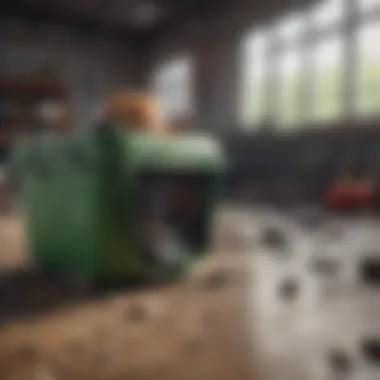Empowering Students Against Plastic Pollution


Nature Topic Overview
Plastic pollution presents a critical environmental challenge contributing to the degradation of ecosystems and the harm of wildlife. Students hold a unique position as both learners and agents of change in their communities. By understanding the issues surrounding plastic pollution, they can take meaningful actions to combat this pressing environmental crisis.
Plastic waste accumulates in various environments, particularly in oceans, where it poses risks to marine species. Understanding the various sources of plastic pollution—like single-use items, packaging, and improper disposal—is essential for students wishing to make a difference. When students engage in proactive measures, they not only contribute to cleaner surroundings but also foster a sense of social responsibility.
The role of students extends beyond awareness. They can initiate projects, advocate for change, and educate their peers. This article delves into practical strategies that students can implement to reduce plastic waste effectively, focusing on their capabilities and the impact they can make.
Fun Facts and Trivia
- Did you know that it takes approximately 450 years for a plastic bottle to decompose? That means plastic items we use today can still exist long after we are gone.
- Over 1 million marine creatures are killed each year due to plastic pollution. This ranges from fish to birds that mistake plastic for food.
- More than 40% of the plastic produced is for single-use items, which means they are discarded after just one use.
These facts can help spark conversations among students. They can be encouraged to think creatively about solutions to these issues.
Wildlife Explorations
Many species of animals and plants suffer due to plastic pollution in their habitats. For instance:
- Sea turtles: Often mistake plastic bags for jellyfish and consume them, leading to injury or death.
- Birds: They can ingest small plastic pieces or feed them to their chicks, causing starvation or internal injuries.
Interactive quizzes about local wildlife can educate students on the importance of protecting these species. For example, ask questions about how plastic affects different animals and what students can do to help.
Environmental Awareness
Understanding the importance of conservation is vital. Here are some ways students can contribute:
- Participate in local clean-up events to collect plastic waste.
- Encourage family and friends to use reusable bags, bottles, and containers.
- Advocate for recycling programs at school and in the community.
Every action counts, no matter how small. Students can learn that by making simple changes in their daily lives, they contribute to a larger movement toward sustainability.
DIY Nature Activities
Engaging students through creativity can reinforce their commitment to fighting plastic pollution. Here are some activities they can try:
- Create a Recycled Art Project: Use plastic bottles and bags to design sculptures or art pieces. Students can brainstorm ideas, gather materials, and present their creations.
- Start a School Garden: Students can learn about sustainable gardening while using biodegradable containers for their plants.
- Nature Walks: Organize outings where students can observe local wildlife. They can note any plastic waste and compare it with their knowledge from earlier sections.
These activities provide hands-on experiences. Students will feel empowered to make a real impact in their environment, leading to a deeper understanding of sustainability and conservation.
Prologue to Plastic Pollution
Plastic pollution is an issue that has gained considerable attention over the last few decades. This topic is critical in today’s world, where plastic usage has expanded significantly, resulting in lasting damage to our environment. Understanding how plastic interacts with ecosystems and human health is essential for anyone concerned about the future of our planet. In this article, we will discuss the depths of plastic pollution, its implications, and the proactive steps that students can take.
Understanding Plastic Pollution
Plastic pollution refers to the accumulation of plastic products in the environment, affecting wildlife, wildlife habitats, and human populations. This phenomenon arises from several sources, including mismanaged waste, overconsumption of plastic products, and inadequate recycling efforts. Everyday items, such as bottles, bags, and straws, contribute significantly to this challenge.


When plastics break down, they do not disappear. Instead, they fragment into smaller pieces known as microplastics. These microplastics can be found in oceans, rivers, and even in the air we breathe. Understanding how plastic pollution functions is vital for recognizing its far-reaching effects on health and biodiversity. For instance, marine animals might ingest these microplastics, leading to harmful consequences that eventually make their way up the food chain.
The Scale of the Problem
The scale of plastic pollution is staggering. According to data, millions of tons of plastic waste enter our oceans each year. Oceans are becoming dumping grounds, accounting for an alarming percentage of marine debris. The Great Pacific Garbage Patch is a prime example of this, showcasing the severity of pollution in our oceans.
- Roughly 300 million tons of plastic are produced each year globally.
- Approximately 8 million tons make their way into oceans annually.
- Microplastics have been discovered even in remote marine environments.
This issue is not confined to oceans alone. Plastic pollution impacts land ecosystems, affecting wildlife and posing risks to agriculture. Deadly toxins can leach from plastics, endangering soil, water supplies, and health. As this problem continues to escalate, it calls for immediate attention, especially from young minds eager to create change.
"Plastic pollution impacts both our environment and our health, necessitating a response from all of us, starting with education."
By grasping the concept of plastic pollution and its scale, students can position themselves as key players in combating this pressing issue. This empowerment begins with understanding the problem at its core.
The Role of Students
Students have a pivotal role in the fight against plastic pollution. Their energy, creativity, and ability to influence peers make them effective agents of change. Engaging students in this challenge not only helps to address environmental concerns but also nurtures responsibility and leadership in the younger generation. This section will explore the reasons why student involvement is essential, as well as the unique advantages they possess in this endeavor.
Why Student Engagement Matters
Student engagement in environmental issues can significantly amplify efforts to combat plastic pollution. When students actively participate in initiatives, they create a ripple effect that can reach their families and friends. This peer influence is crucial because it encourages discussions about the environment, thereby fostering a culture of sustainability. Engaging students also empowers them to become informed advocates for change.
The benefits of student engagement include:
- Increased Awareness: As students learn more about plastic pollution, they can share this knowledge with others, spreading awareness.
- Innovation: Students often bring fresh perspectives and innovative ideas, which can lead to effective solutions for reducing plastic waste.
- Community Involvement: By getting involved, students can lead community projects that address local plastic pollution issues.
"Engaged students not only improve their schools but also contribute to their communities and the planet."
Unique Position of Students
Students occupy a unique position in the fight against plastic pollution. They are inherently adaptable and tapping into their potential can have meaningful outcomes. Their daily routines and environments present constant opportunities for improvement and changes regarding plastic use.
Some aspects of their unique position include:
- Accessibility: Students often have access to various platforms, including social media, enabling rapid dissemination of ideas and initiatives.
- Collective Power: When mobilized, students can form a large, powerful collective. Their numbers can pressure authorities and businesses to take action against plastic pollution.
- Education System Support: Many schools are beginning to incorporate environmental education into their curriculums, allowing students to learn about these issues systematically.
Educational Initiatives
Educational initiatives serve a vital role in addressing plastic pollution. They are not just about teaching students what plastic pollution is, but also about equipping them with practical skills and knowledge to take action. This is fundamental for fostering a sense of responsibility towards the environment. Initiatives related to education can inspire students to think critically about their daily choices and promote a culture of sustainability in schools and communities.
By engaging in educational initiatives, students become informed advocates. They learn about the environmental impact of plastic waste, including the harm it causes to marine life and ecosystems. This understanding can lead to a deeper connection with their environment and a commitment to play a part in its protection. Furthermore, educational programs on plastic pollution can stimulate interest in related fields like environmental science, biology, and chemistry.
Some specific benefits of educational initiatives include:
- Hands-On Learning: Students can participate in projects that allow them to apply what they learn in practical settings. This reinforces their understanding and retention of information.
- Skill Development: Educational initiatives can teach students essential skills such as critical thinking and problem-solving.
- Community Engagement: Students often work within their communities to promote awareness and change, creating a ripple effect that can lead to broader environmental impact.
- Building Leadership: Initiatives enable students to take on leadership roles, fostering qualities like teamwork, communication, and organization.
In summary, educational initiatives not only impart knowledge but also motivate students to become proactive in addressing pressing environmental issues like plastic pollution.


Initiating School Projects
Starting school projects focused on plastic pollution offers an excellent way for students to engage with the issue directly. Such projects can range from simple activities like cleaning up local parks to more extensive initiatives like developing recycling programs within the school. These projects should aim to create a lasting impact while also educating students about plastic pollution.
When initiating a project, it is crucial to establish clear goals. For instance, a student-led recycling initiative might set a goal to reduce the use of single-use plastics in the cafeteria. Determining these goals early on provides direction and motivates participation. Teamwork is another essential element; involving classmates ensures that various ideas and creativity are fostered.
Additionally, measuring progress through data collection or feedback is important. For example, tracking how many plastic bottles are collected during cleanup drives provides tangible results and can motivate further involvement.
Collaborating with Teachers
Collaboration with teachers amplifies the impact of student initiatives against plastic pollution. Educators provide valuable support, resources, and guidance to ensure students' efforts are effective. Teachers can integrate environmental education into their lessons, making it a part of everyday learning.
Collaboration may involve co-developing projects where teachers lend their expertise, especially in science and social studies. This gives students the chance to learn more about environmental issues and enhances their understanding. For example, conducting a science project that analyzes waste in the school can yield data for further initiatives to reduce plastic use.
Involving teachers also helps with securing resources. Teachers can assist in obtaining materials for projects or finding funding through grants or school budgets. Furthermore, presenting findings or initiatives in classroom discussions elevates the importance of these topics within the school.
Practical Steps to Reduce Plastic Use
The significance of reducing plastic use cannot be overstated, especially in an era where the consequences of plastic pollution are becoming increasingly evident. It is vital that students take practical steps in their everyday lives to minimize plastic waste. This not only contributes to a cleaner environment but also fosters a culture of sustainability among peers.
Students, as future leaders, have the power to set examples for their communities. By understanding and implementing practical steps to reduce plastic use, they can embody the change they wish to see. Benefits include a direct impact on one’s surroundings, learning valuable eco-conscious habits, and inspiring others to join in the movement against plastic pollution.
Eliminating Single-Use Plastics
Single-use plastics are items designed for one-time use only, such as plastic bags, straws, and cutlery. These products are prevalent due to their convenience but pose a significant threat to the environment. Eliminating them is essential for several reasons.
- Environmental Impact: Many single-use plastics end up in landfills or oceans, harming wildlife and ecosystems.
- Resource Conservation: Reducing reliance on single-use plastics decreases the demand for new plastic production, which consumes non-renewable resources.
- Health Benefits: Some studies suggest that chemicals in plastics can leach into food and beverages, posing health risks.
To combat single-use plastics, students can:
- Refuse plastic straws in favor of metal or paper ones.
- Carry reusable bags when shopping to avoid plastic bag use.
- Use personal containers for takeaways instead of plastic ones.
Adopting Reusable Alternatives
Switching to reusable alternatives is another effective strategy in combating plastic pollution. Reusable items can significantly reduce plastic waste and offer a sustainable lifestyle choice. The advantages of adopting these alternatives are clear:
- Durability: Reusable products often last longer than their single-use counterparts, providing a better value over time.
- Versatility: Many reusable items, such as containers and bottles, can be used in various situations, making them practical for daily life.
- Cost-Effective: Although some reusable products may require an upfront investment, they save money in the long run by eliminating the need for constant purchases of single-use items.
Examples of reusable alternatives include:
- Stainless steel water bottles instead of plastic ones.
- Cloth bags for shopping instead of plastic bags.
- Glass or metal containers for meals instead of plastic Tupperware.
Innovative Recycling Practices
Recycling is an integral part of reducing plastic waste. However, innovative practices can enhance effectiveness beyond traditional methods. Students can explore creative ways to recycle, ensuring materials do not end up in landfills. Such practices can include:
- Upcycling: Turning old or unused plastic items into new products or art projects. This not only reduces waste but also encourages creativity.
- Community Clean-Up Drives: Organizing events to clean local areas and recycle materials collected can create a strong sense of community.
- Education on Recycling Protocols: Teaching peers about local recycling rules and proper sorting can increase recycling rates within the community.


"Every small action contributes to a larger goal. By making simple changes in daily habits, you can create a ripple effect that impacts the environment positively."
By taking these practical steps, students can significantly reduce their plastic footprint. This commitment to action not only helps mitigate plastic pollution but also solidifies their role as responsible stewards of the environment.
Advocacy and Awareness Campaigns
Advocacy and awareness campaigns are fundamental in the fight against plastic pollution. They serve as a bridge connecting knowledge and action. The essence of these campaigns lies in raising consciousness about the dire consequences of plastic waste. They not only inform individuals but also inspire collective action. Students, as active participants, can help lead these efforts within their communities.
By engaging in advocacy, students learn to communicate effectively. They become more than passive receivers of information; they become agents of change. Campaigns allow students to express their views on environmental issues, building a sense of responsibility and ownership.
Key Benefits of Advocacy and Awareness Campaigns:
- Increased Knowledge: Awareness campaigns help spread information about plastic pollution. Knowledge empowers communities to make informed decisions.
- Community Involvement: Engaging local communities can create a supportive environment. Shared efforts amplify the impact.
- Behavior Change: Campaigns often lead to changes in behavior. As people become aware, they may adopt more eco-friendly practices.
- Long-term Sustainability: Advocacy fosters a culture of sustainability, encouraging ongoing efforts to combat pollution.
Creating Awareness in the Community
Community awareness is crucial for effective advocacy against plastic pollution. It creates a ripple effect. Students can take various initiatives to spread awareness, such as organizing clean-up events and workshops.
One way to create awareness is through educational programs in schools. These programs can include:
- Workshops on Recycling: Teaching the importance of recycling can inform students about proper disposal methods. Understanding what can be recycled reduces contamination.
- Plastic Pollution Exhibits: Displays that demonstrate the impact of plastic can visually engage community members. They can be eye-opening and provoke discussions.
- Participatory Activities: Involving the community in activities, such as beach clean-ups or art projects with recycled materials, encourages hands-on learning.
This approach cements the knowledge gained and solidifies a commitment to action.
Utilizing Social Media for Change
Social media plays a significant role in advocacy. Platforms such as Facebook, Instagram, and TikTok allow students to reach a broader audience. They can share their thoughts and push for the cause efficiently.
Strategies to utilize social media include:
- Creating Informative Posts: Students can share facts about plastic pollution. Infographics and short videos can be effective in capturing attention on platforms like Instagram.
- Starting Campaigns with Hashtags: Using specific hashtags can help connect like-minded individuals. For example, a hashtag like #PlasticFreeFuture can unify efforts and spread the message.
- Collaborating with Influencers: Partnering with social media influencers who value environmental issues can increase reach. These individuals can help amplify student voices.
In summary, advocacy and awareness campaigns are essential tools in the fight against plastic pollution. By focusing on community awareness and leveraging social media, students can create a powerful movement towards a plastic-free future.
End
The examination of the role of students in combating plastic pollution brings us to a significant conclusion. The need for environmental action has never been more critical. As this article outlined, student engagement presents unique opportunities not only for personal growth but also for community impact. Understanding the responsibility that lies with the younger generation sets a foundation for more sustainable future practices.
The Future of Environmental Responsibility
The direction of environmental responsibility hinges largely on the actions of today’s youth. Students have the ability to shape policy and influence community standards. With proper guidance and resources, they become catalysts for change. The future can illustrate a world where plastic pollution is drastically reduced.
Positive trends in youth activism can be noted. In recent years, movements led by young people gain traction globally. They advocate for environmentally-friendly policies and practices that prioritize sustainability. Therefore, when students engage in tackling plastic pollution, they participate not only in their local issues but contribute to a broader movement.
Empowerment Through Action
Empowerment arises when students take direct steps to reduce plastic waste. Actions range from individual choices to collective school initiatives.
- For example:
- Organizing beach clean-ups to directly address local pollution
- Starting recycling programs at school
- Promoting awareness campaigns within their communities
Such initiatives can be greatly rewarding. Not only do these activities lead to immediate impacts on the environment, but they foster leadership and collaboration skills in students. The feeling of making a tangible difference can inspire further efforts both in their immediate circle and beyond.







